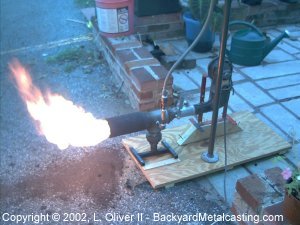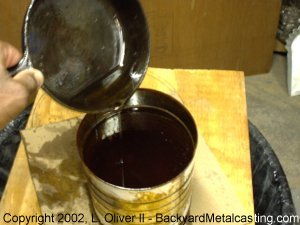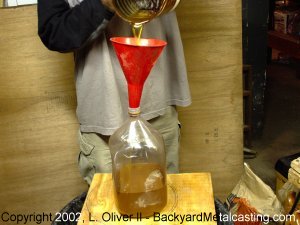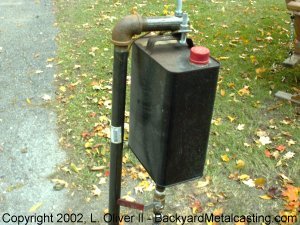
This is my first oil burner which is working but I won't call it a success. Controling and maintaining the flame isn't easy or practicle. This flame produced a little smoke and would leave a lot of soot in the furnace. And if you're wondering... no, this is not a Babington burner. There is a watering can in the background but it is NOT to put out any oil fire. Water is one of the WORST things to use when putting out oil fires (it spreads it and gets it to flare up more)! Cover the fire with dirt or sand.
Believe it or not the picture above shows what I consider a "lazy flame". Look how soft and "loopy" it is. And notice how quickly it starts arching upward. Plus there is a little smoke coming off the top. A soft flame may be good for hot water heaters but it's not for metalcasting. This one will leave soot all over the furnace and therefore needs a more forceful air blast to tap the real power of this flame!

I collect used cooking oil by pouring it into a steel can straight from the frying pan. Every time some fish or chicken is fried I pour the oil into this can and store it. The bits of fish, french fry etc. settle to the bottom and I can pour off relatively clean oil. Any well used cooking oil will do. For those who demand the best for their foundry I suggest extra virgin olive oil imported from Italy or Greece.

For easy refueling and storage I pour the used oil into a container (in this case the empty olive oil bottle). The solid matter settled to the bottom forming a thick crust that stayed in the can so I didn't have to filter the WVO (waste vegetable oil). This oil is ready to be poured into the fuel tank.
Chef: Oh my God! There's a grease fire in the kitchen! Do something!
Metalcaster: Ok, hold on... I'll get some aluminum!

Here's a quick look at the fuel tank. It's nothing more than a 1-gallon steel can that I attached a threaded fitting to the bottom of leading to the fuel line. The tank is hanging from a fixture made from a steel pipe. Gravity feeds the oil into the burner and valves regulate it.

There's just a little flame coming out now since I closed the valve down some. The Lab has expended a LARGE CHUNK of its department of energy research budget into the development of a new burner... And that $10.00 went a long way. Here's a different oil burner design.